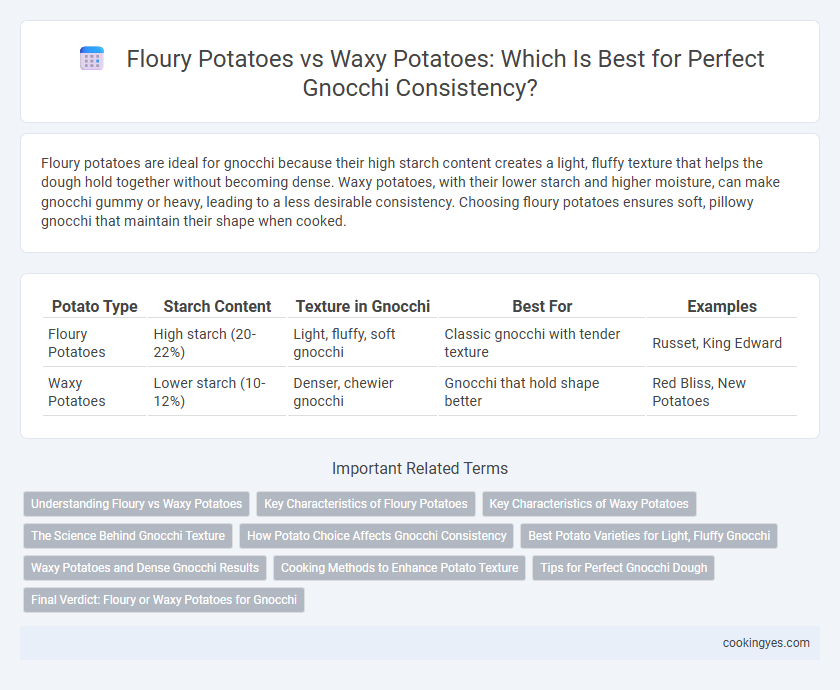Floury potatoes are ideal for gnocchi because their high starch content creates a light, fluffy texture that helps the dough hold together without becoming dense. Waxy potatoes, with their lower starch and higher moisture, can make gnocchi gummy or heavy, leading to a less desirable consistency. Choosing floury potatoes ensures soft, pillowy gnocchi that maintain their shape when cooked.
Table of Comparison
| Potato Type | Starch Content | Texture in Gnocchi | Best For | Examples |
|---|---|---|---|---|
| Floury Potatoes | High starch (20-22%) | Light, fluffy, soft gnocchi | Classic gnocchi with tender texture | Russet, King Edward |
| Waxy Potatoes | Lower starch (10-12%) | Denser, chewier gnocchi | Gnocchi that hold shape better | Red Bliss, New Potatoes |
Understanding Floury vs Waxy Potatoes
Floury potatoes, such as Russets, have a high starch content and low moisture, resulting in light, fluffy gnocchi with a tender texture ideal for absorbing sauces. Waxy potatoes like Red Bliss contain more moisture and less starch, producing denser, chewier gnocchi that hold their shape well but may be less airy. Choosing floury potatoes ensures a perfect balance of softness and structure in traditional gnocchi recipes.
Key Characteristics of Floury Potatoes
Floury potatoes, such as Russets or Yukon Gold, have a high starch content and low moisture, making them ideal for creating light and fluffy gnocchi with a tender texture. Their dry, mealy flesh absorbs less water during cooking, which helps maintain the dough's consistency and prevents it from becoming sticky or dense. Choosing floury potatoes ensures gnocchi that are soft yet hold their shape well when boiled.
Key Characteristics of Waxy Potatoes
Waxy potatoes, such as Red Bliss and New Potatoes, have a high moisture content and low starch level, resulting in a firm and moist texture ideal for gnocchi that holds shape well during cooking. Their smooth skin and dense flesh contain less starch, which contributes to a chewy, less fluffy consistency compared to floury potatoes. This makes waxy potatoes perfect for gnocchi recipes requiring a firm bite and resistance to disintegration in boiling water.
The Science Behind Gnocchi Texture
Floury potatoes, high in starch and low in moisture, create a light and airy gnocchi texture by absorbing less water during cooking. Waxy potatoes contain more moisture and less starch, resulting in denser, chewier gnocchi that can become gummy when overworked. Understanding the starch-to-water ratio in potato varieties is essential for achieving the ideal gnocchi consistency and preventing a heavy or sticky final product.
How Potato Choice Affects Gnocchi Consistency
Floury potatoes, such as Russets, yield light and fluffy gnocchi with a soft, pillowy texture due to their high starch content that helps absorb flour evenly. Waxy potatoes like Red Bliss or Yukon Gold contain more moisture and less starch, resulting in denser, chewier gnocchi that hold their shape better but lack the same airy consistency. Selecting floury potatoes is key for achieving tender gnocchi that melt in your mouth, while waxy varieties create a firmer bite with more resilience during cooking.
Best Potato Varieties for Light, Fluffy Gnocchi
Floury potatoes like Russets or Yukon Golds provide the ideal texture for light, fluffy gnocchi due to their high starch content and low moisture, which helps the dough hold together without becoming dense or sticky. Waxy potatoes, such as Red Bliss or Fingerlings, have higher moisture and lower starch, often resulting in gummy or heavy gnocchi textures. For the best gnocchi consistency, select floury potato varieties that yield a tender, pillowy bite and maintain structural integrity during boiling.
Waxy Potatoes and Dense Gnocchi Results
Waxy potatoes, with their higher moisture content and lower starch levels, produce gnocchi that is denser and chewier compared to the light and fluffy texture achieved with floury potatoes. Their firm flesh helps the dough hold together better, resulting in compact gnocchi that maintain shape during boiling. Using waxy potatoes is ideal for recipes where a robust and hearty texture is preferred.
Cooking Methods to Enhance Potato Texture
Floury potatoes, such as Russets, produce light and fluffy gnocchi due to their high starch content, which helps absorb moisture during boiling and baking, resulting in a delicate texture. Waxy potatoes, like Red Bliss or Yukon Gold, retain their shape better but yield denser and firmer gnocchi because of their low starch and higher moisture levels. Optimal cooking methods for enhancing potato texture include baking whole potatoes to prevent water absorption, then ricing them while still hot to maintain dryness, which ensures the perfect balance of lightness and elasticity in the final gnocchi.
Tips for Perfect Gnocchi Dough
For perfect gnocchi dough, selecting floury potatoes like Russets is essential due to their high starch content, which yields a light and fluffy texture. Avoid waxy potatoes such as red or new potatoes since their moisture and lower starch produce dense, gummy dumplings. Use freshly cooked, cooled potatoes and handle the dough gently to prevent excess gluten development, ensuring tender gnocchi consistency.
Final Verdict: Floury or Waxy Potatoes for Gnocchi
Floury potatoes are ideal for gnocchi because their high starch content creates a light, fluffy texture that holds shape well when cooked, preventing dense or gummy results. Waxy potatoes contain more moisture and less starch, making the dough sticky and difficult to handle, often leading to heavier, less tender gnocchi. For optimal consistency and traditional softness, floury potatoes like Russets or Maris Piper remain the preferred choice in gnocchi preparation.
Floury potatoes vs waxy potatoes for gnocchi consistency Infographic

 cookingyes.com
cookingyes.com